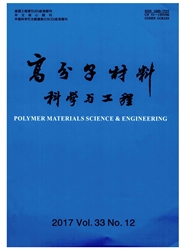

 中文摘要:
中文摘要:
采用AFM(原子力显微镜)和QCM-D(带损耗测量的石英晶体微天平)等技术研究了聚乳酸、聚碳酸酯和聚甲基丙烯酸甲酯三种合成高分子材料经旋转成膜后的表面形貌、亲疏水性、水合过程及蛋白吸附行为。结果发现,薄膜的疏水性越强,蛋白吸附量越多,蛋白层的粘弹性越小;且吸附在材料表面的蛋白分为可逆吸附和不可逆吸附两部分,可逆部分可被PBS(磷酸盐缓冲溶液)洗脱,而不可逆吸附蛋白由于在疏水力作用下构象发生变化,变得致密无法脱附,粘弹性比发生可逆吸附的蛋白更小。用Langmuir吸附速率方程可较好地拟合薄膜的蛋白吸附动力学曲线,发现薄膜疏水性越强,白蛋白吸附速率越快。
 英文摘要:
英文摘要:
The surface topography, hydrophobicity, hydrated process and protein adsorption behavior of poly (lactic acid), polycarbonate and polymethylmethacrylate were investigated with the quartz crystal microbalance (QCM) with dissipation monitoring and atomic force microscopy (AFM) techniques. The result reveals that: with the hydrophobicity of film increased, protein adsorbed amount increases while viscoelastic property of protein layer adsorbed decreases. There are two types of protein adsorbed on the surface: one is reversible, another is irreversible. The reversible part will be resolved into phosphate buffered solution(PBS) after rinsing, however the irreversible part will remain on the films with the changed conformation and more rigid property. Langmuir model is found to fit with the protein adsorption dynamics curves well. The result shows that adsorption rate constant increases with the hydrophobicity of films.
 同期刊论文项目
同期刊论文项目
 同项目期刊论文
同项目期刊论文
 Synthesis and biological evaluation of the Zn (II)–IDB complexes appended with oligopolyamide as pot
Synthesis and biological evaluation of the Zn (II)–IDB complexes appended with oligopolyamide as pot 期刊信息
期刊信息
